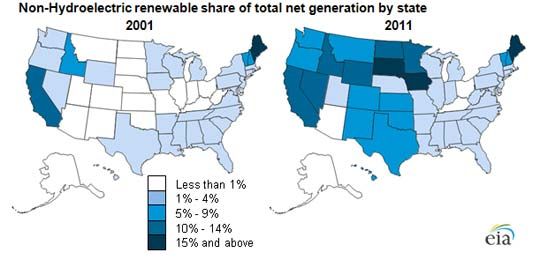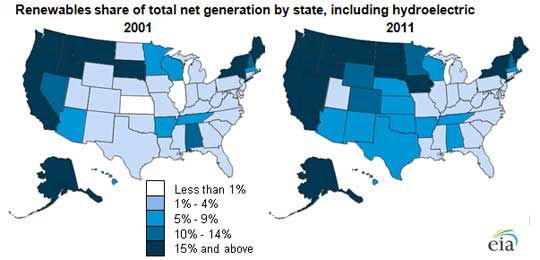The past decades have seen a jump in renewables in many states -- even if hydro is left out of the picture.
The new data from the U.S. Energy Information Administration is not shocking, but it is promising, as states work toward their renewable portfolio standards. All but four states saw some increase in renewables, with about 20 seeing 5 percent growth of non-hydro renewables.

The figures are even more important when you take into consideration that the data stems from the power plant operations report, meaning that small, distributed renewables, such as rooftop solar, are not taken into consideration.
Wind, which makes up the largest share of renewables outside of hydroelectric, pushed many states above 15 percent. Maine was the winner with 27 percent of in-state generation coming from non-hydro renewables, primarily wind.
South Dakota and Iowa followed with 21 percent and 17 percent, respectively. Although Maine is currently first, growth in South Dakota and Iowa are more impressive, as both states had less than 1 percent in 2001.
When hydro is added back into the picture, the renewables picture gets even more interesting. Thirteen states boast more than 15 percent renewables, with many Pacific Northwest states seeing the majority of their power production from hydro.

Although the figures will continue to grow, the expiration of many production tax credits could slow the rate of expansion, especially of large-scale wind. However, as transmission lines are built, especially in Texas, wind power that has already been sited and built can be better utilized.
Wind, solar and biomass may be growing, but make no mistake about it, coal is still king. Consumption of coal is at its lowest level in nearly two decades, but it still makes up more than 40 percent of electricity consumed.
However, by 2035, the picture will be quite different. Wind could be 9 percent of overall U.S. electricity generation. And while gas is positioned to take over, many leaders in the utility industry warn against an over-reliance on any single source of generation, including gas.
“When gas is that cheap, there’s no need for renewables,” Jim Rogers, CEO of Duke Energy, warned on a panel held by The New York Times, “and our industry has to be all of the above.”



